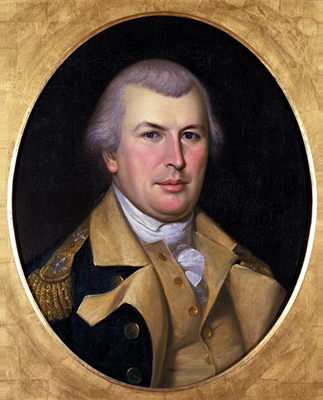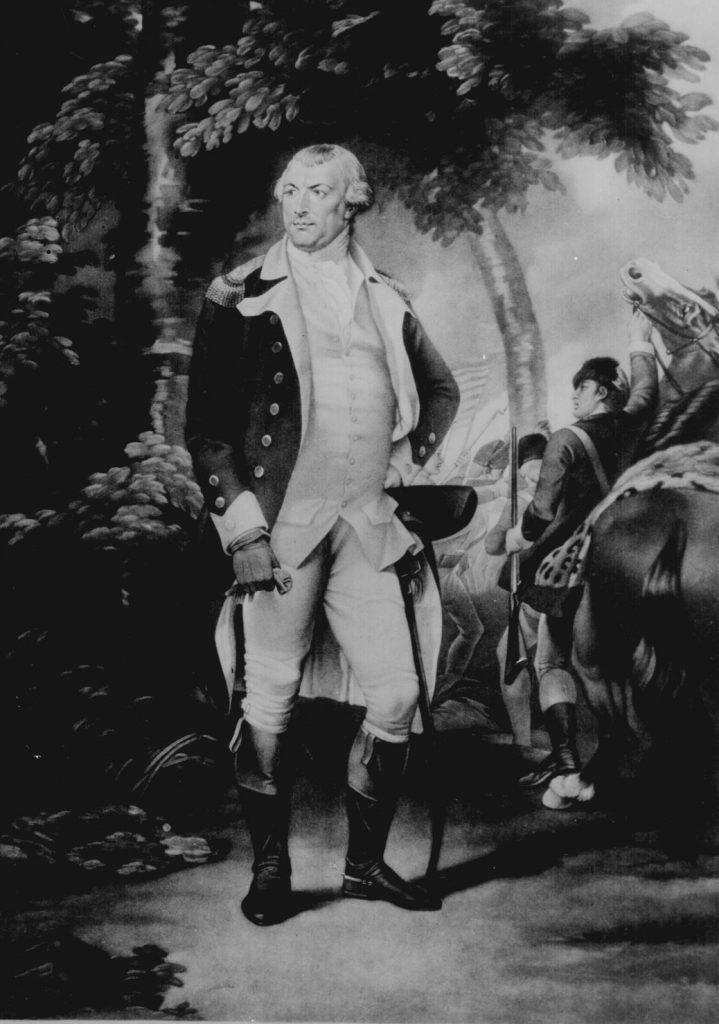Following the American Revolutionary War, Nathanael Greene was considered to be the most gifted and dependable officer to General Washington, having started off as a militia private and making his way up to a major general in the Continental Army. He is most notably known for successfully commanding during the Southern Campaign when he forced Lieutenant General Charles Cornwallis and his British troops out of the Carolinas.
Nathanael Greene was born on August 7, 1742 in Warwick, Rhode Island to Quaker farmer and smith Nathanael Greene and Mary Mott. They were descendants of some of the founding settlers of their hometown, Warwick, Rhode Island. Greene educated himself in mathematics and law since his father’s sect did not encourage “literary accomplishments”. Reverend Ezra Stiles was a huge influence for your Nathanael Greene.
Shortly before the death of his father, Greene left Warwick and moved to Coventry, Rhode Island. There, he took over the family-owned foundry. Greene was the first to urge a public school to be established, which led to him being chosen to serve on the Rhode Island General Assembly. He was reelected in 1771, 72, and 75.
Catharine “Caty” or “Kitty”Littlefield began to court Greene in 1772. She was much younger than him, having been born in 1755. Two years later, Nathanael Greene married Catherine Littlefield in July. They lived in a home in Coventry. Not long after their marriage, he was called off to serve in the war and Catharine took over the role as head of the household. She was known to be both energetic and independent, but for the most part, looked to her husband for all decision making. Five of their children survived past infancy: George Washington Greene, Martha Washington Greene, Cornelia Lott Greene, Nathaniel Ray Greene, and Louisa Catherine Greene.
In August of 1774, Greene began helping to organize a local militia in Coventry. A few months later in October, the militia was charted as the Kentish Guards. However, Greene was pronounced limp, which led to his participation being challenged. He began to buy many books on military tactics and was able to teach himself on the art of war through this. That December, Greene was a part of a committee the assembly had appointed to revise militia laws.
Greene faced challenged with his faith by being apart of the military. As a Quaker, he struggled to commit to pacifism. it ended up with his expulsion from the pacifist Quakers before the war officially began.
In response to the Siege of Boston in early 1775, the Rhode Island Army of Observation was formed. Greene was then promoted to major general from his rank as a private on May 8, 1775. He soon joined the Continental Army, being appointed a brigadier on June 22, 1775. When the British evacuated Boston the following March, George Washington left Greene in charge of the city. Throughout the entire Revolution, Greene would wear a masonic jewel given to him by the Marquis de Lafayette, his Masonic Brother.
Greene was rising quickly, On August 9, 1776, he was appointed to be one of four new major generals. With this new rank, he was given command of troops on Long Island. While at Long Island, Greene decided where to put the fortifications and watched over his men as they constructed redoubts and entrenchments. Due to a terrible illness though, Greene was unable to take part in the Battle of Long Island on August 27, 1776.
As plans to retreat from New York City began to happen, Greene took a big part in them. He was an advocate for burning the city to try and get the British to leave, justifying this with the argument that most property in the city was owned by Loyalists. Despite Washington agreeing to Greene’s plan, Congress did not. So instead, Greene took over command of Fort Constitution (which later on became Fort Lee) on the Hudson River in New Jersey. On October 25, 1776, Greene succeeded General Israel Putnam when he was then put in command of Fort Washington. Fort Washington was located just across the river from Fort Constitution. Shortly after, Washington sent him orders to defend Fort Washington no matter what. Colonel Robert Magaw was then ordered to defend the fort until he was to hear from Greene again. Even though Greene was absent, he was blamed for the losses of Fort Constitution and Washington at the Battle of Fort Washington on November 16, 1776. Washington did not lose confidence in him though.
The following month, Greene took part in the battle of Trenton on December 26, 1776. He commanded one of America’s two columns at the battle. And after the American victory, he urged Washington to immediately advance on Princeton. The council of war overruled him on this though.
Greene was also there at the Battle of Brandywine the following September, commanding the reserve. However, that October, him and his troops were unable to reach Germantown, Pennsylvania in time. His command failed at the battle and Greene feared that he would lose Washington’s trust, but did not.
On March 2, 1778, Greene was at Valley Forge when Washington requested he accept the position of Quartermaster General. It was a difficult position, as he was to act as chief of staff for the commanders of the army. He took it with an understanding that he retained the right to command troops on the field. Later that year on June 28, 1778, he was at the head of the right wing at the Battle of Monmouth.
Greene, alongside the Marquis de Lafayette, commanded the land forces that were sent to Rhode Island that August. These men were being sent to take place in an expedition that was co-operated with the Comte d’Estaing, a French admiral. The Battle of Rhode Island on AUgust 29, 1778 turned out to be unsuccessful for the Americans.
After commanding at the Battle of Springfield in the summer of 1780, Greene resigned from Quartermaster General in August. He had been going through a long, bitter struggle with Congress over the Treasury board interfering in the army administration. While Congress favorited individual states proving equipment for the army, Greene did not.
Savannah and Charleston had both been lost due to poor selection of commanders on Congress’s part. Washington was entrusted to choose the successor of Horatio Gates after the Battle of Camden on August 16, 1780. He wrote to Greene saying that he wished to appoint him. The appointment was approved and Greene was given command of troops all the way from Delaware to Georgia. Meanwhile, Cornwallis was pursuing his goal of gathering Loyalists from the south and heading to Virginia. On December 3, 1780, Greene took command in North Carolina.
Despite the badly equipped Continental Army in comparison to Cornwallis’s superior forces, Greene still advanced on him. He made the decision to divide his own troops, which forced the British to divide theirs as well.
The campaign began with the Battle of Kings Mountain in South Carolina, a victory for the Americans. At the battle, the entirety of the british forces were captured or killed, so it was a major success. On January 17, 1781, the Battle of Cowpens was a success as well. Almost all of the British forces were captured or killed (about 9/10ths).
Daniel Morgan, who had been at command at Cowpens, met with Greene in North Carolina at Cowan’s Ford. Morgan had more than 800 prisoners with him. Greene summoned his field officers on February 9 when they arrived at Guilford. The officers voted for the army continuing to retreat. That way, they could gain even more forces. The following day, Greene wrote to request more troops from Patrick Henry.Simultaneously, Greene was also forming a special light corps that Colonel Otho Williams would command. It would cover the retreat for the main army.
Greene and his army had already outrun the British by February 14. They crossed the Dan River in Halifax County, Virginia. On the 22nd, they recrossed the river to pursue Cornwallis. On March 15, 1781, Greene was in command at the Battle of Guilford Court House in North Carolina. The battle ended with a British victory, yet a Pyrrhic one at that. Later on, Greene led the siege of the Ninety-Six, taking place from May 22-June 19. The siege was unsuccessful as well, leading to the British being forced to the coast.
For six weeks, Greene and his forces rested on the Hills of the Santee River in South Carolina. On September 8, they engaged at the Battle of Eutaw Springs. The battle was a tactical victory for the British, but a strategic victory for the Americans. But it did weaken the British and they withdrew to Charleston. Greene was able to later on pin the British down in Charleston as well.
Despite being beaten in every battle fought during the Southern Campaign, Greene showed remarkable strategic tactics and mastered in dividing, eluding, and tiring his opponents, specifically through long marches.
Greene served as the president of the Rhode Island Society of the Cincinnati from the time of its founding in 1783 until he died in 1786. Georgia, North Carolina, and South Carolina all voted to give Greene grants of money and land. He was given “Boone’s Barony”, an estate in South Carolina. he later sold it to pay for the rations of his army in the south. Greene was also given Mulberry Grove Plantation in Georgia, the very same place where the cotton gin was invented. Twice, Greene also refused the post of Secretary of War.
In 1785, he settled into Mulberry Grove. The following year on June 19, 1786, he died there at forty-three years old. His remains were interest in Savannah at the Graham Vault in Colonial Park Cemetery. 114 years after his death, they were moved to a monument at Johnson Square.



